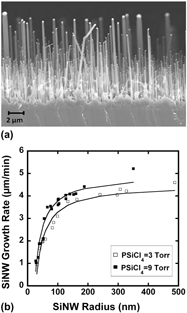Crossref Citations
This article has been cited by the following publications. This list is generated based on data provided by
Crossref.
Kendrick, Chito E.
and
Redwing, Joan M.
2011.
The effect of pattern density and wire diameter on the growth rate of micron diameter silicon wires.
Journal of Crystal Growth,
Vol. 337,
Issue. 1,
p.
1.
Cao, Tengfei
Zhang, Haibao
Yan, Binhang
Lu, Wei
and
Cheng, Yi
2014.
Optical emission spectroscopy diagnostic and thermodynamic analysis of thermal plasma enhanced nanocrystalline silicon CVD process.
RSC Adv.,
Vol. 4,
Issue. 29,
p.
15131.
Redwing, Joan M.
Miao, Xin
and
Li, Xiuling
2015.
Handbook of Crystal Growth.
p.
399.
Park, Yi-Seul
Jung, Da Hee
Kim, Hyun Ji
and
Lee, Jin Seok
2015.
Annealed Au-Assisted Epitaxial Growth of Si Nanowires: Control of Alignment and Density.
Langmuir,
Vol. 31,
Issue. 14,
p.
4290.
Usman, Mohammad A. U.
Smith, Brady J.
Jackson, Justin B.
De Long, Matthew C.
and
Miller, Mark S.
2015.
Titanium-Catalyzed Silicon Nanostructures Grown by APCVD.
Journal of Electronic Materials,
Vol. 44,
Issue. 1,
p.
38.
Shaner, Matthew R.
Hu, Shu
Sun, Ke
and
Lewis, Nathan S.
2015.
Stabilization of Si microwire arrays for solar-driven H2O oxidation to O2(g) in 1.0 M KOH(aq) using conformal coatings of amorphous TiO2.
Energy & Environmental Science,
Vol. 8,
Issue. 1,
p.
203.
Chen, Christopher T.
Emmer, Hal S.
Aloni, Shaul
Turner-Evans, Daniel B.
and
Atwater, Harry A.
2015.
Cu-Catalyzed Vapor–Liquid–Solid Growth of SiGe Microwire Arrays with Chlorosilane and Chlorogermane Precursors.
Crystal Growth & Design,
Vol. 15,
Issue. 8,
p.
3684.
Park, Yi‐Seul
Kim, Hyun Ji
and
Lee, Jin Seok
2016.
Size‐Dependent Surface Migration of Au Alloys on Si Nanowires at Different Cooling Rates.
Chemistry – An Asian Journal,
Vol. 11,
Issue. 24,
p.
3487.
Park, Yi-Seul
and
Lee, Jin Seok
2017.
Correlating Light Absorption with Various Nanostructure Geometries in Vertically Aligned Si Nanowire Arrays.
ACS Photonics,
Vol. 4,
Issue. 10,
p.
2587.
Kendrick, Chito
Kuo, Meng-Wei
Li, Jie
Shen, Haoting
Mayer, Theresa S.
and
Redwing, Joan M.
2017.
Uniform p-type doping of silicon nanowires synthesized via vapor-liquid-solid growth with silicon tetrachloride.
Journal of Applied Physics,
Vol. 122,
Issue. 23,
Zarraoa, Laura
González, María U.
and
Paulo, Álvaro San
2019.
Imaging low-dimensional nanostructures by very low voltage scanning electron microscopy: ultra-shallow topography and depth-tunable material contrast.
Scientific Reports,
Vol. 9,
Issue. 1,
Lee, Han Ju
Park, Chul Soon
Park, Yi-Seul
Aboumourad, Rami
Marquez, Maria D.
Lee, Jin Seok
and
Lee, T. Randall
2020.
Covalently Bound Gold Nanoparticle-Assisted Epitaxial Growth of Silicon Nanowires.
Crystal Growth & Design,
Vol. 20,
Issue. 8,
p.
5551.
Thakur, Esha
Ye, Tang
Zhang, Yong
Zhang, Haitao
and
Walter, Michael G.
2023.
A Quantitative Analysis of the Effect of Various Growth Parameters on the Lithography-Free Grown Si Microwires for Photodetector Applications.
Silicon,
Vol. 15,
Issue. 18,
p.
7785.
